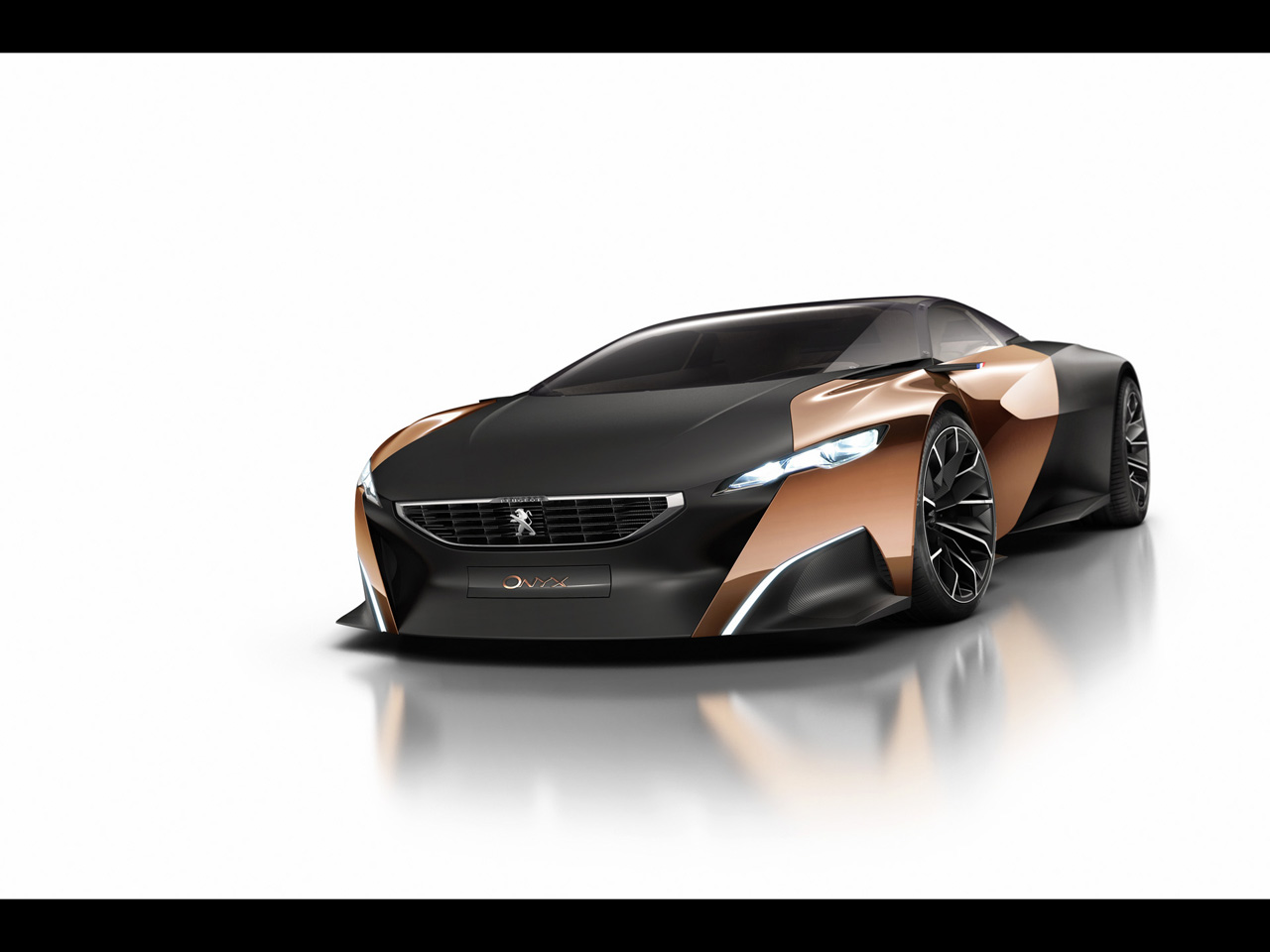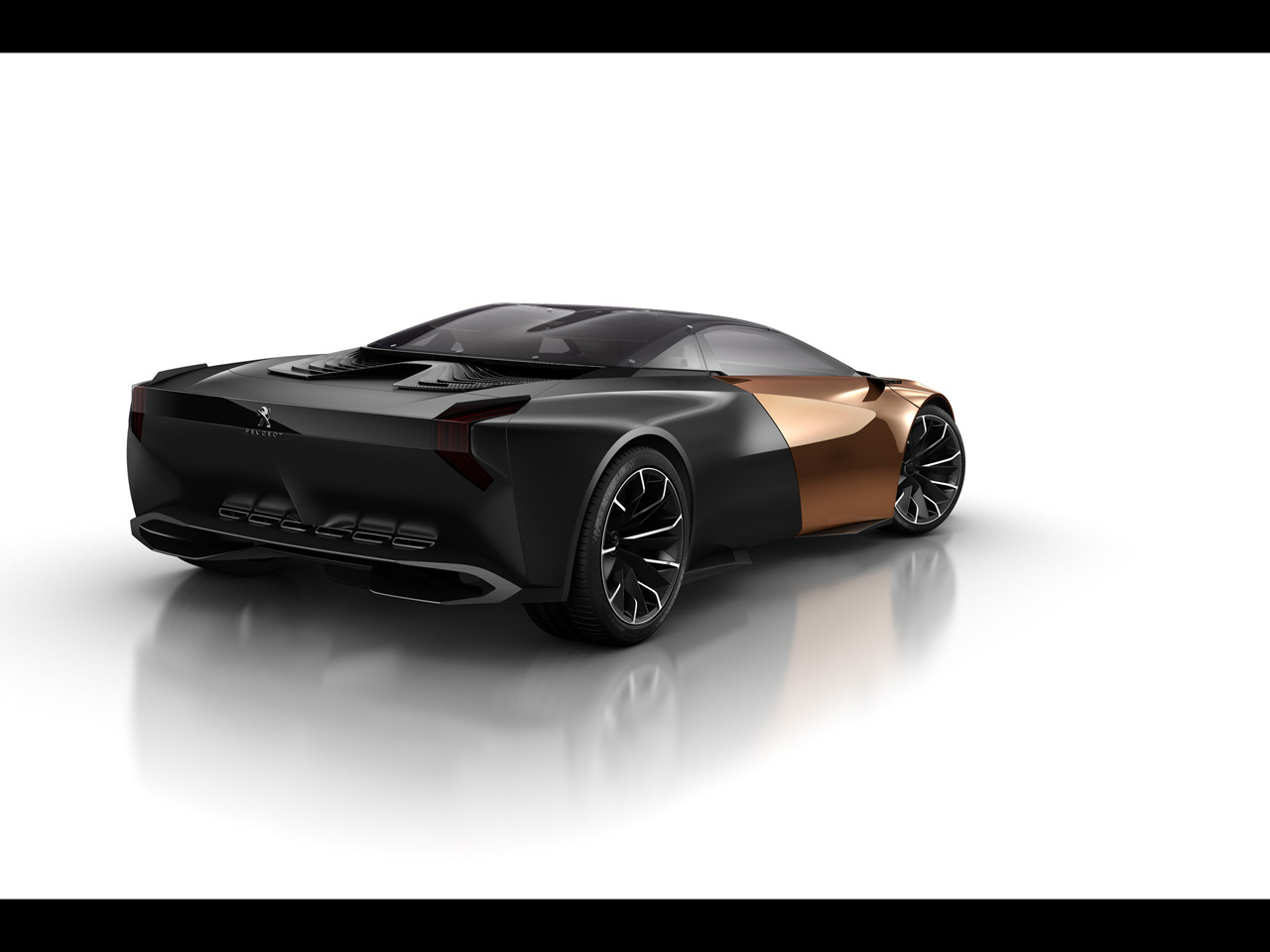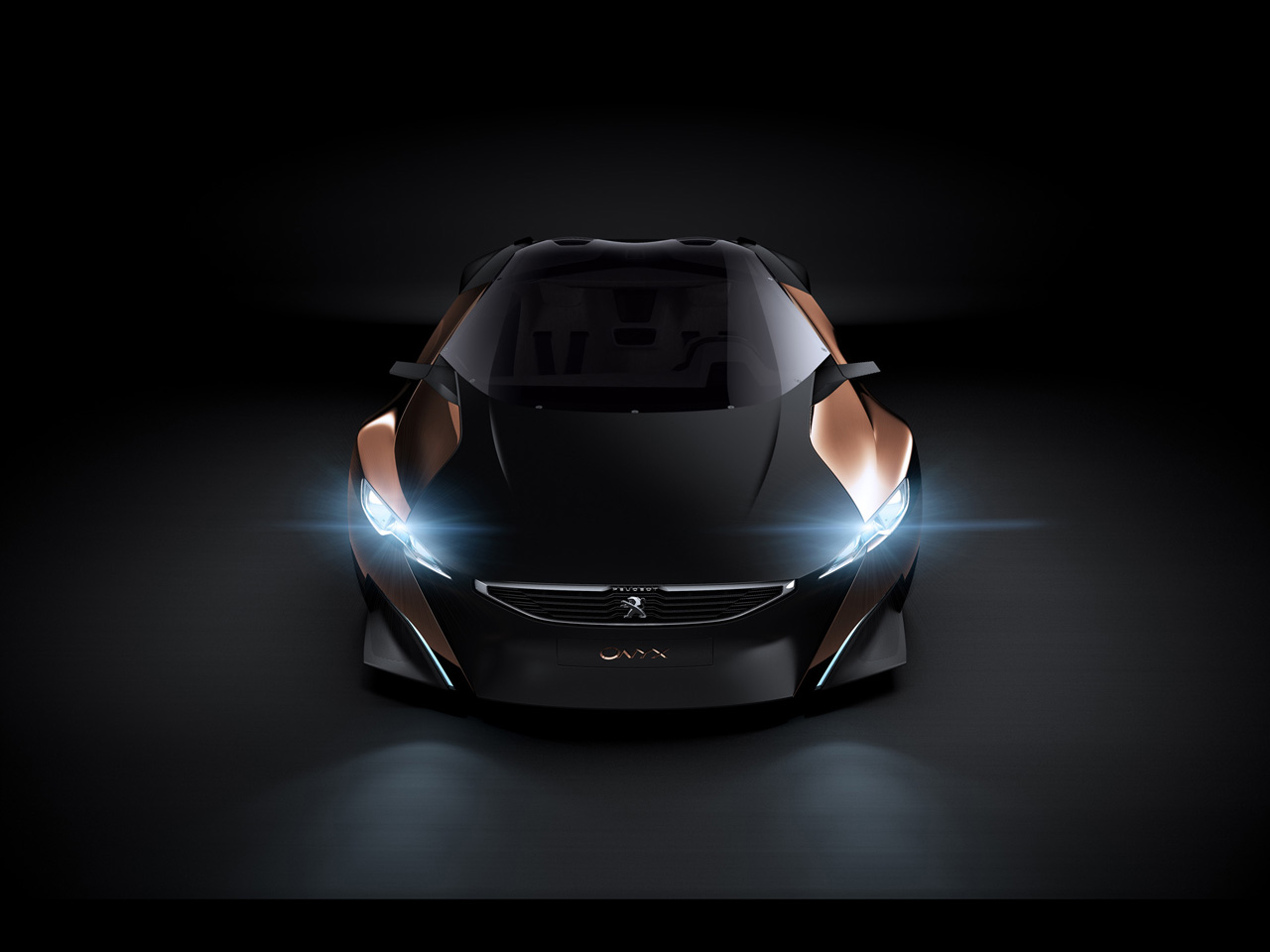2012 Peugeot Onyx Concept
|
Price |
-- |
Production |
-- | ||
|
Engine |
3.7 liter V8 hybrid |
Weight |
2425 lbs | ||
|
Aspiration |
-- |
Torque |
-- | ||
|
HP |
600 hp |
HP/Weight |
4 lbs per hp | ||
|
HP/Liter |
-- |
1/4 mile |
-- | ||
|
0-62 mph |
-- |
Top Speed |
-- |
(from Peugeot Press
Release) Onyx, an audacious use of materials and efficiency
Quasar, Proxima, Oxia, 907 ... Peugeot Supercars have always
attracted attention, be it in the eyes of the young or the
experienced. In 2012, the Marque is again creating the dream with
the supercar of the 21st century: Onyx.
Shaped using raw materials innovatively, this supercar has been
created by enthusiasts who have drawn their inspiration from the
world of racing. With its mid-mounted V8 engine, Onyx propels
admirers in a world of high performance, controlled at all times
through a cockpit with intuitive instrumentation and controls.
Beyond its breath-taking beauty, it explores the application of new,
primary materials to take efficiency even further.
The passion for innovation has continued over 202 years of historic
developments from Peugeot, one of the most established automotive
brands in the world. Furthermore, it is also unique in being able to
offer a full range of personal mobility transportation, with:
bicycles, scooters, cars and light commercial vehicles.
The Onyx Concept Bike
and Onyx Concept Scooter are a further expression of that vision in
their respective domains.
“Onyx has supercar performance, with extremely aerodynamic lines. It
has a unique sculpted shape, styled with innovative materials and an
innovative architecture.”
Gilles Vidal, Peugeot Style Director
A sharply dressed design
The body form is sharp
with a striking contrast of materials and colours. The wings and
doors are handcrafted by a master craftsman from a single sheet of
pure copper. Polished like a mirror, the metal remains unprotected
to the elements. It will evolve in appearance over time, through a
natural patina effect. So Onyx lives! Other body panels are formed
in carbon, and painted matt black.
Shaped to be efficiently aerodynamic, the front ‘face’ links the
vertical grill and the full LED headlights, to produce a streamlined
surface. The airflow is then separated; part penetrates into the
heart of the car, flowing within the body, for supplying air to the
engine. The other part of the airstream spreads across the car sides
and over its ‘double-bubble’ roof into the air intakes.
Onyx ends with a flourish, the tail-lights perpetuate the three-claw
light signature characteristic of Peugeot. They also support small
vanes, which direct the flow of air over the top and side. They meet
as far as possible from the body to reduce interference. With a Cd
of 0.30, the aerodynamic footprint of Onyx is inversely proportional
to its visual impact.
Linking experience with the future, Onyx incorporates the present by
honouring the iconic RCZ with a subtle characteristic
‘double-bubble’ roofline and aluminium roof arches. Fully
transparent, revealing the strong carbon structure and the interior,
the windows and the roof are made of PMMA (PolyMethyl MethAcrylate),
enclosing the cocoon that provides maximum occupant protection.
“Onyx has a svelte silhouette with a sculpted form that goes from
smooth, sensual to sharp and technologic. From the very first
sketches, I wanted to create a showcase of technological excellence
and craftsmanship using high performance aerodynamic cues, ‘black
diamond glass house’ and body panels hand-shaped in copper.” Sandeep
Bhambra, Exterior Designer of Onyx
The performance supercar
The frame of the car is
an innovative piece of design, developed with the expertise of
Peugeot Sport and the research and development teams. Made of
Monolithic carbon, this central structure consists of only 12 parts.
It integrates the front with the rear, increasing torsional
stiffness and the mass of the structure is optimised, weighing in at
only 100kg.
Bolted to the carbon shell, the V8 hybrid HDi FAP 3.7-litre engine,
and the suspension were also developed with the expertise of Peugeot
Sport that has been acquired and validated on circuits around the
world. Cooled by twin NACA ducts on the roof, the V8 transmits its
600bhp to the rear wheels via a 6-speed sequential gearbox. This
power is delivered in a vehicle of ideal proportions: 4.65m long,
2.20m wide, 1.13m high, weighing just 1,100kg.
Fitted with specially developed Michelin tyres, 275/30 at the front
and 345/30 at the rear, with 20'' rims and equipped with double
wishbone suspension and in-board springs and damping.
Intelligent, HYbrid4 technology recovers the kinetic energy normally
lost during braking. Stored in lithium-ion batteries, this energy is
then automatically returned when accelerating, boosting the power
with an extra 80bhp. The management of this function is evident to
the driver, supplementing the driving enjoyment. Drawing on the
experience of a competitive environment, the engine has been tuned
specially for the challenges of road application.
With an impressive power-to-weight ratio, at less than 2kg per brake
horsepower, Onyx achieves very high performance without affecting
the purity and elegance of its style. To do so, Onyx has a flat
carbon underside, which creates a powerful ground effect. Thus, the
aerodynamic elements are kept at a minimum, by extensions of the
carbon structure and the movable rear wing that loads the rear axle
during braking, which is provided by four carbon discs; with a
diameter of 380mm front and 355mm at the rear.
An innovative driving environment experience
For the driver to gain
access into the interior, the doors provide easy access through a
sophisticated Pantographic mechanism design with two movements. On
opening, the copper outer skin separates from the door frame, hinged
on the door’s outer edge, to ensure the body style aspect is
maintained.
The interior is bright and natural, from the floor to the roof. The
intuitive design and the materials used to construct its structure
characteristics are all on view. As with the bodywork, the interior
is frugal in its use of materials, resulting in a minimalist
interior, in close proximity to the occupants. For the materials
chosen and how they should be used and implemented, Onyx explores
their life cycles. Onyx demonstrates it is possible to reconcile
customer demands, with high performance and preservation of natural
resources.
“We sought to use the materials fit for a modern supercar, to ensure
the components specified fully justified inclusion. Carbon for its
strength and lightweight performance, copper and PMMA for their
virtues, felt and paper for their natural elements – all used
efficiently.”
Sophie Gazeau, Colour & Materials Designer
Made of felt, compressed and stretched, the cockpit is modelled in a
one piece cockpit ‘tub’, with no seams or joins. The carbon
structure combined with the felt surface creates a protective cocoon
around its occupants, allowing it to function ergonomically while
incorporating all the features previously performed by individual
components: soundproofing, floor, high console, roof and bucket
seats.
The occupants are integral within one homogeneous piece that also
reduces weight. Sports comfort has been integrated with the
insertion of foam under the felt, in the areas of contact with the
body.
Warm and soft, the felt is derived from traditional production
techniques. Obtained from boiled wool, with interwoven fibres, this
material is completely recyclable and is an excellent thermal
insulator. In addition, it improves the quality of the surrounding
air by dehumidifying.
“For the interior, it was inspired by an object of everyday life –
‘the egg box’. With a remarkable economy of material, it is
perfectly designed through ergonomics and structure to protect its
fragile contents. We adapted the concept into an intuitive space
with minimum componentry, but where every function fit perfectly to
the hand.” Julien Cueff, Interior Designer
On board, the driver has all the controls in full view, without
having to take his eyes off the road ahead. The felt trimmed
steering wheel falls naturally to the hands to provide an immediate
feeling of agility. Within the carbon ‘tub’, aluminium controls
drive the functions of the Peugeot Onyx, while the paddles control
gear selection.
The dashboard is constructed with of a new type of ‘timber’ –
‘Newspaper Wood’. Produced from used newspapers, assembled and
compressed to create a new material from which the parts are made.
The illusion is beautiful with veins of colour evident on the
surface. On closer inspection the secret is revealed with the
appearance of the print type.
The dashboard houses the heads-up display cluster which shows the
engine activity and the vehicle’s speed on metal components,
appearing and disappearing, like the keys of a piano. The operation
of the hybrid activation is indicated by digital displays. Installed
in the roof is a selection of aluminium toggle switches that include
the start switch for the engine. Just behind it, a reflective blade
displays rear view camera images: two located in the mirrors, the
third, which provides a panoramic view, positioned on the rear
panel.
Also covered in felt, the central console celebrates the expertise
of the craft of the master glass blower with a masterpiece in glass
crystal. This fuel gauge ‘reservoir’ visually indicates the level of
fuel in the tank using etched indicator markings for capacity. It
also contains in an inner shell, the smell of this supercar.
Released into the cabin by aerators, the fragrance captures the
essence of the materials used. Finally, the console features
dual-zone air conditioning controls made from milled solid aluminium,
where the milling paths in the material are used as grips for the
hand.
The beauty of this interior and dynamic experience is captured
internally by a camera installed between the headrests. The film is
then available to be replayed on a tablet device, inserted into the
dashboard facing the passenger and providing an interface for the
car infotainment, capturing the experience for posterity.
An efficient superbike, the Onyx Concept Bike
Backed by the considerable experience of Peugeot Cycles in competition, the teams have designed a CLM (Contre La Montre), time trial, bike. This is a timely return to the Marque's roots, in the world of speed and efficiency.
In 1998, a Peugeot bike
broke the downhill record on snow, reaching 212.139km/h. The Marque
was also the first, in the Tour de France, to use futuristic and
revolutionary CLM bikes. In fact, the engineers had already been
inspired by the motor industry with work in a wind tunnel, a carbon
monocoque frame, profiled wheels, disc brakes.... and, for the
cyclist, a plastic coated suit with 0% coefficient of penetration.
For the Onyx Concept Bike, the designers of Peugeot Cycles were
inspired by the Onyx Supercar Concept to design a CLM bike, which
propels the Marque into the future with a modern and efficient
style.
A machine for beating time
The taut and mastered
lines of the carbon monocoque frame optimise the aerodynamics of the
Onyx Concept Bike. Also made in this material, the 80mm high wheels
and the saddle post are profiled for overall performance. Nothing is
left to hinder the efficiency of movement. So, the cables, the
brakes and the battery are fully integrated. This battery supplies
the aircraft wing instrument panel, where the cyclist intuitively
finds the electric controls for changing gear.
The riding position can be adjusted with precision so that the
athlete becomes at one with their bike. To get the best possible
efficiency out of their physical condition, oval-shaped pedals
optimise the delivery of power. The cyclist now has a stylish and
efficient CLM with which to compete with style in their race against
the air and time.
"Designing a Time Trial bike is a real challenge, but Peugeot Cycles
carries performance and style in its genes. Drawing on this
considerable experience we created the Onyx Concept Bike - a
beautiful, high-performance, competitive bike – perfect for the Tour
de France."
Sandrine Bouvier, Cycles Product Manager
A hybrid supertrike, the Onyx Concept Scooter
The cities are changing,
and with them the products of transportation. At the crossroads,
between a motorised two-wheeler and a car, the Onyx Concept Scooter
offers an original and innovative alternative on three wheels able
to transform into a motorbike or a scooter as needed, as desired.
Borrowing its stylistic codes from the Marque's cars, this
two-in-one supertrike reveals an athletic silhouette with sculptural
lines and an extra-large 200/50 R17 rear tyre exuding the spirit of
hypersport motorbikes.
Of a size suitable for open spaces, as well as for the city, the
intelligent design of the Onyx Concept Scooter allows its rider to
choose to use it as a motorbike or scooter: so, it offers two
configurations reconciling driving pleasure and practicality.
"The world of the scooter is transforming very rapidly around new
expectations, new uses and new customers. Peugeot Scooters is
driving this development and blurring the boundaries between
motorised two- and four-wheeled vehicles."
Thierry Sanseigne, Peugeot Scooters Marketing and Style Director
Hybrid engine
Equipped with a plug-in
hybrid engine, this supertrike combines a 400cc internal combustion
engine with an electric motor to drive the rear wheel. Due to its
combined power of 45kW, it has a top speed of 150km/h (93.2mph) and
sets itself apart with an above standard torque output of 58Nm
permitting exceptional acceleration.
During deceleration, it recovers energy which is stored in the
lithium-ion batteries and delivered during acceleration. Consuming
only 2 L/100 km (117.6mpg), it has a range of 30km (18.6miles) at
50km/h (31mph) in ZEV mode, but can cover a combined range of up to
500km (310miles).
Alternative driving choices
At ease on all routes
due to the performance of its hybrid engine and exceptional
suspension system and wheels, the Onyx Concept Scooter is not just a
three-wheel scooter: with two driving positions to choose from, it
adds another dimension and reveals a new form of individual
transportation which has two modes: Sport or Urban.
In Sport mode, the rider's position is inclined forwards, leaves no
room for doubt, it is only for pleasure. With the wrists in contact,
feet at the rear, the rider is at one with the Onyx Concept Scooter
in a naturally aerodynamic position.
In Urban mode, the rider can adopt a more conventional position,
feet forward and head up, better suited to weaving through traffic.
The motorbike transforms into a scooter and, as the city demands
that a vehicle is above all practical, the designers thought was to
add, as a priority, a storage compartment, using the space between
the seat and the front of the vehicle. Positioned in the centre
and so lowering the centre of gravity, this removable ClipBox,
perfectly integrated in the design of the Onyx Concept Scooter, can
hold two helmets easily or the items necessary for a weekend escape.
Matt black and Copper
Irresistible, the Onyx Concept Scooter and Onyx Concept Bike are adorned with matt black paintwork to enhance the elegance and accentuates the style. Touches of copper subtly highlight the technology used.
Marque
Present in 160 countries, with 10,000 points of contact, Peugeot combines rigorous design and passion in all its activities.
In 2011, Peugeot achieved 2,114,000 sales worldwide, accelerated its internationalisation in the major growth markets and continued its range enhancement. The Marque is reaffirming its environmental commitment by deploying e-HDi diesel micro-hybridation and launching three full diesel hybrid HYbrid4 models in 2012 .
Peugeot is the only marque to offer a complete mobility product range with cars and utility vehicles, scooters, bicycles and a wide range of services, including the Mu mobility service.



